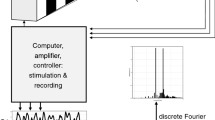Abstract
Introduction
The estimation of visual acuity (VA) via visual evoked potentials (VEP) is a valuable measure for all preverbal and non-verbal subjects whether adults or children. The aim of this study is to introduce a novel technique of VEP acquisition based on estimates of signal-to-noise ratio (SNR) and comparison to a predefined detection threshold. We aim to demonstrate the reduction in total study time without compromising the accuracy of the VEP-determined acuity estimate.
Methods
The VEP-determined acuity of twelve normal subjects was assessed via a spatial frequency (SF) sweep. A pattern reversal checkerboard stimulus utilised SFs ranging from 0.1 to 28 cycles per degree (cpd). Using linear extrapolation and Bland–Altman analysis, VEP-acquired acuity was compared to a conventional Snellen Acuity measurement. An SNR test, Fsp, assessed signal quality to determine the minimum amount of sweep data required for VEP-based VA estimation.
Results
VEP acuity estimates correlated strongly (r 2 = 0.91, SD = 0.06), leading to a VA limit via extrapolation. Bland–Altman analysis revealed agreement between tests is statistically valid (95 % CI −0.11 to 0.42 logMAR). The Fsp statistic indicated SFs 1.3–3.6 cpd yielded Fsp >3.1 within 15 s of acquisition with frequencies >3.6 cpd being sub-threshold. The Kruskal–Wallis statistic compared final Fsp values for SFs as groups, where F = 208.82 ranking each frequency, with frequencies >7.2 cpd ranking lowest.
Discussion
The Fsp as an SNR measurement shows that rapid, quality-driven clinical tests for VEP-based acuity estimates can be conducted without compromising accuracy.



Similar content being viewed by others
References
Regan D (1977) Speedy assessment of visual acuity in amblyopia by the evoked potential method. Ophthalmologica 175:159–164
Tyler CW, Apkarian P, Levi DM, Nakayama K (1979) Rapid assessment of visual function: an electronic sweep technique for the pattern reversal visual evoked potential. Invest Ophthalmol Vis Sci 18:703–713
Ridder WH (2004) Methods of visual acuity determination with the spatial frequency sweep visual evoked potential. Doc Ophthalmol 109:239–247
Mackay AM, Bradnam MS, Hamilton R, Elliot AT, Dutton GN (2008) Real-time rapid acuity assessment using VEPs: development and validation of the step VEP technique. Invest Ophthalmol Vis Sci 49:438–441
Norcia AM, Tyler CW (1985) Spatial frequency sweep VEP: visual acuity during the first year of life. Vision Res 25:1399–1408
Odom JV, Bach M, Brigell M, Holder GE, McCulloch DL, Tormene AP, Vaegan (2010) ISCEV standard for clinical visual evoked potentials. Documenta Ophthalmologica 120:111–119
Daniel C, Wood FS (1980) Fitting equations to data. Wiley-Interscience, New Jersey
Bland JM, Altman DG (1986) Statistical methods for assessing agreement between two methods of clinical measurement. Lancet 327:307–310
Elberling C, Wahlgreen O (1985) Estimation of auditory brainstem response by means of bayesian inference. Scand Audiol 14:89–96
Don M, Elberling C, Waring M (1984) Objective detection of averaged auditory brainstem responses. Scand Audiol 13:219–228
Elberling C, Don M (1987) Detection functions for the human auditory brainstem response. Scand Audiol 16:89–92
Kruskal WH, Wallis WA (1952) Use of ranks in one-criterion variance analysis. J Am Stat Assoc 47:583–621
Yadav NK, Almoqbel F, Head L, Irving EL, Leat SJ (2009) Threshold determination in sweep VEP and the effects of criterion. Doc Ophthalmol 119:109–121
Lenassi E, Likar K, Stirn-Kranjc B, Brecel J (2008) VEP maturation and visual acuity in infants and preschool children. Doc Ophthalmol 117:111–112
Bach M, Wilke M, Wilhelm B, Zrenner E, Wilke R (2010) Basic quantitative assessment of visual performance in patients with very low vision. Invest Ophthalmol Vis Sci 51:1255–1260
Arai M, Katsumi O, Paranhos FR, Lopes De Faria JM, Hirose T (1997) Comparison of Snellen acuity and objective assessment using the spatial frequency sweep PVER. Graefe’s Arch Clin Exp Ophthalmol 235:242–247
Katsumi O, Arai M, Wajima R, Denno S, Hirose T (1996) Spatial frequency sweep pattern reversal VER acuity vs Snellen visual acuity: effect of optical defocus. Vision Res 36:903–909
Adoh TO, Woodhouse JM (1994) The Cardiff acuity test used for measuring visual acuity development in toddlers. Vision Res 34:555–560
Acknowledgments
This project was approved by the Human Research Ethics Committee (HREC), University of Queensland (Approval No. 2009001430).
Author information
Authors and Affiliations
Corresponding author
Rights and permissions
About this article
Cite this article
Iyer, K.K., Bradley, A.P. & Wilson, S.J. Conducting shorter VEP tests to estimate visual acuity via assessment of SNR. Doc Ophthalmol 126, 21–28 (2013). https://doi.org/10.1007/s10633-012-9355-9
Received:
Accepted:
Published:
Issue Date:
DOI: https://doi.org/10.1007/s10633-012-9355-9




